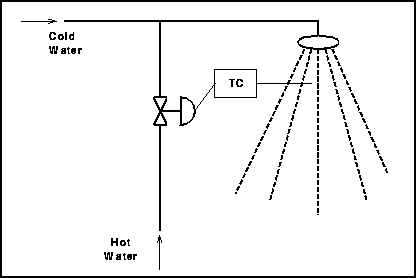
The aim of this section is to introduce the concept of control systems, what their function is and what hardware and software is required by them.
First start with a simple manual control system, to examine how control is introduced, how the control system is constructed and how it works.
A diagram of the system is shown below.

To begin with the shower is cold. To start the heating process the valve in the hot water line is opened. The operator can then determine the effectiveness of the control process by standing in the shower. If the water is too hot, the valve should be closed a little or even turned off. If the water is not hot enough then the valve is left open or opened wider.
It can be seen that this control system, completed by the operator, possesses the following functions:
This is ultimately the materilisation of the order for the adjustment. The left hand of the operator takes the necessary actions following the order from brain.
Therefore, for a control system to operate satisfactorily, it must have the abilities of measurement, comparison, computation and correction.
Of course, the manual operation has obvious disadvantages e.g. the accuracy and the continuous involvement of operators. Although accuracy of the measurement could be improved by using an indicator, automatic control must be used to replace the operator. In industry, it is automatic control that is widely used.
Based on the above process, we can easily set up an automatic control system as shown in the next figure.

First we have the Controlled Variable. This is the basic process value being regulated by the system. It is the one variable that we are specially interested in - the outlet water temperature in the example above. In feedback control the controlled variable is usually the measured variable.
An important concept related to the controlled variable is the Setpoint. This is the predetermined desired value for the controlled variable. The objective of the control system is to regulate the controlled variable at its setpoint.
To achieve the control objective there must be one or more variables we can alter or adjust. These are called the Manipulated Variables. In the above example this was the input hotwater flow rate.
Conclusively, in the control system we adjust the manipulated variable to maintain the controlled variable at its setpoint. This meets the requirement of keeping the stability of the process and suppressing the influence of disturbances.
In the Virtual Control Laboratory there is an experiment which shows a control system in action. This example is based on the hot water thermostat mentioned in Module 1.1 - The Very Basics. It describes how the control system is put together and then how it works. In this simple example feedback on/off control is used to regulate the temperature of the hot water at its setpoint. Note that a link to this experiment can also be found in the Case Study Section for this part of the HyperCourse.
Go to Hot Water Tank Experiment